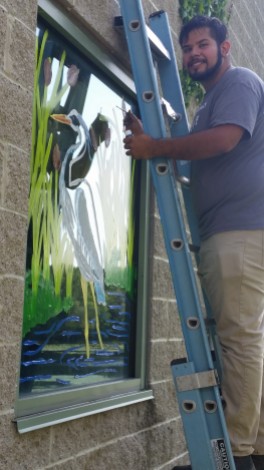Most of us have experienced that sudden thud against the window, and we peek outside only to see a stunned sparrow lying limp on the ground. Sadly, bird-building collisions kill up to one billion birds each year in the United States. Some ornithologists believe that collisions with human-built structures are the leading cause of migratory bird mortality in North America.
There are a few reasons why these collisions occur. During the day, windows reflect the sky, trees, and other surroundings in a bird’s urban or suburban habitat, or a bird may see potted plants on the other side. Because they can’t detect the pane of glass, they fly into it unknowingly. Collisions also happen at night, especially during migration. Birds that migrate at night are attracted to the bright lights left on in buildings overnight in urban areas. Additionally, territorial birds may collide with a window in attempt to chase the “other” bird away.
Fortunately, steps can be taken to help reduce bird mortality due to collisions with buildings. For example, windows can be marked with soap, decals, tape, and other things to help make windows more detectable by birds. But when staff at Chincoteague National Wildlife Refuge did not have success with these measures, they were committed to doing further research. Their newly built visitor center was designed with several massive windows. Upon the building’s completion, they began to experience bird deaths due to collisions with the windows; they were averaging one bird death per week.
In 2013, a summer intern named Hope Kanarvogel was moved to take on the problem and attempt to save some feathered friends. After some initial research, she made contact with a company that sells a paracord-based system to prevent bird-window collisions. They also provide detailed instructions on their website on how to make your own cord system. Generally, the paracord is fastened to a runner above the window and to one below the window so that vertical lines – spaced about three inches apart – break up reflections in the glass.
Hope gathered the supplies which consisted of wooden runners and bulk paracord and got to work. Supplies totaled about $50. With a little help from colleagues, the cord system was fully assembled and installed in two days. And while the system has not eliminated the problem altogether, it has significantly reduced the number of collisions from one per week to one per month at Chincoteague.
Similarly, staff at Patuxent Research Refuge in Laurel, Maryland, have had comparable success has with a “zen wind curtain” which is the same basic design as was used at Chincoteague, except the bottom of the paracord is not secured. Visitor Services Manager, Jennifer McNicoll, is very happy with the success they have had in reducing bird strikes with windows at their staff offices. McNicoll was once an employee at the Hawk Mountain Sanctuary in Pennsylvania where the “zen wind curtain” was designed. She says that they have been able to reduce bird mortality due to window strikes at the staff offices by 100 percent. McNicoll suggests soaking the paracord before hanging to allow it to shrink before installation.
Other successful techniques being used at Patuxent include perforated screening, artistic window decals, and tempera paint. The perforated screening allows people inside to see out but appears opaque to birds on the outside. McNicoll admits that while the screening is effective, it is not the most aesthetically pleasing solution. Enter artist Lynne Parks. The Baltimore-based artist is known for her photographic portraits of birds that have died from window strikes. Parks was commissioned to design a series of silhouettes of local flora and fauna that were printed and installed on a film that now covers four of the visitors’ center windows.
Additionally, tempera-paint murals have been painted on the outsides of windows at Patuxent that make them more visible to birds. McNicoll is currently spearheading a campaign that encourages schools and students to get creative with paint on windows to reduce strikes at their schools.
Other inexpensive solutions to bird-window collisions offered by the Cornell Lab of Ornithology include marking windows with soap, hanging sun catchers, mylar tape, affixing masking tape, and even sticky notes. It is important that anything applied to the window is affixed to the outside of the window to be seen by birds. Most of these techniques are only effective when placed close together (about three inches apart) and covering most of the window. Generally, one or two raptor silhouettes will not prevent bird collisions with glass.
While the numbers of bird deaths due to window strikes are staggering, the good news is that we can greatly reduce the danger to birds. At your home or office building, identify problem windows by going outside and looking at the windows from a bird’s point of view. If you see trees or sky reflected in the glass, that’s how birds will see it, too. With a little bit of effort and a few supplies, everyone can contribute to bird safety around buildings.
 Jennifer Lynch Murphy is a wildlife biologist with C&S Engineers, specializing bird-aircraft collisions. She lives in Sunderland, MA with her husband, Kevin, and dog, Levi.
Jennifer Lynch Murphy is a wildlife biologist with C&S Engineers, specializing bird-aircraft collisions. She lives in Sunderland, MA with her husband, Kevin, and dog, Levi.









These solutions look good for commercial buildings but here at home we have been leaving our screens in the window all year long. Fewer birds are striking the screens (< 1 per month) and those that do, bounce off and do not die; the screen is softer than the glass. We do have a 'beak hole' now in one screen about 1/4" diam and don't know who made it.